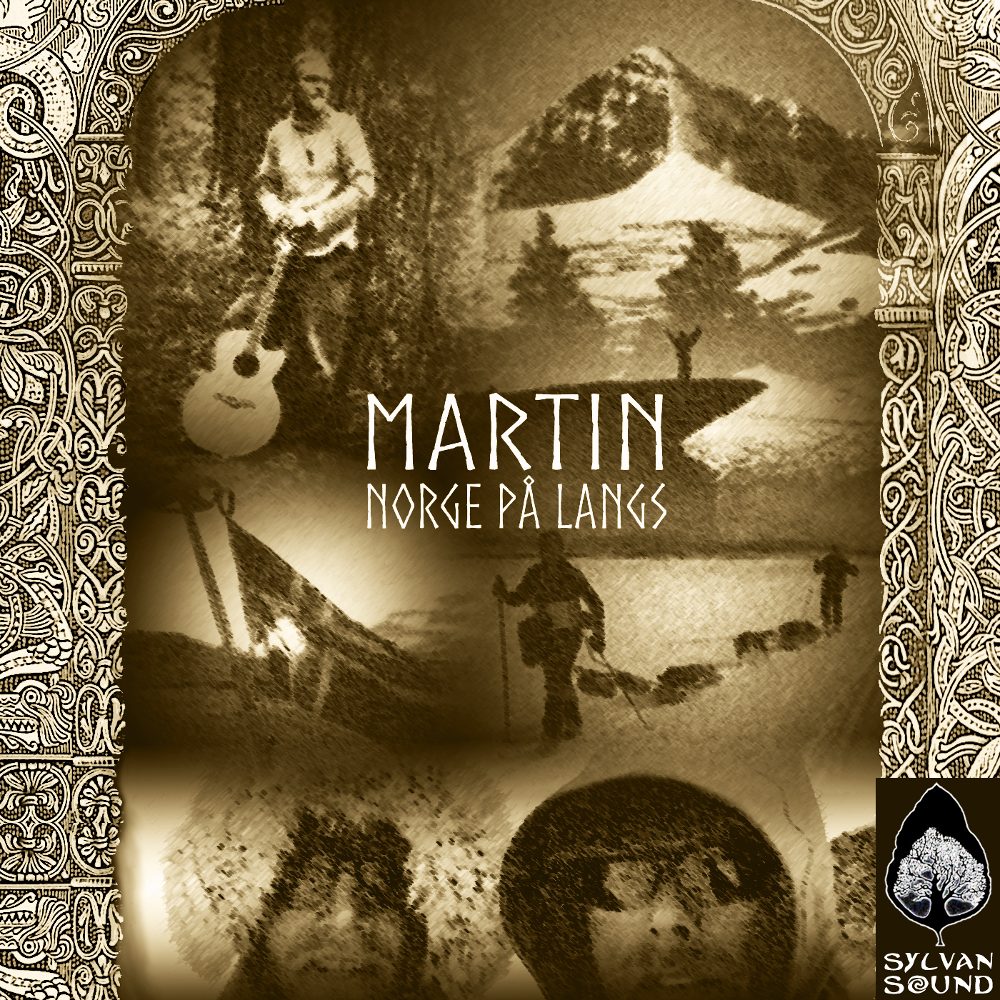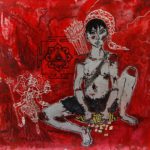Description
Martin – Norge På Langs
[Released October 2018. Also available on iTunes, Spotify, Apple Music, etc.]
Free single
- Hei Fara Martin 4:37
In 2008 Martin’s brother Anders and his friend Knut embarked on an extreme expedition from the North Cape of Norway to the southernmost point in Lindesnes, attempting to ski and walk 2500km in four months through mountains and valleys, inhumane freezing temperatures in the north and spring floods in the south, while making the journey all the more arduous by staying exclusively on the rugged Norwegian side of the border with Sweden.
So when asked to edit their footage into a documentary film and to record a soundtrack to it, Martin equally chose to make an album of exclusively Norwegian and mostly traditional music, thus taking viewers and listeners on a rare journey through an epic Norwegian musical landscape that reflects the unique Norwegian spirit and nature. His decision to create the music first and later edit the film to the music makes the project even more interesting, leaving us with a fully stand-alone album rather than just a soundtrack.
However, with Martin’s eclectic background and influences and with participating musicians from India, Canada and Mexico, Norge På Langs – Norway Lengthwise is an untraditional take on traditional music. In addition to the three original tracks written by Martin and one modern pop song cover, the album’s one indigenous Sami and nine Norwegian traditional folk songs join a fancy-dress viking beer hall fusion party in outfits of flamenco, hard rock, blues, pop, tribal, bluegrass… thus offering Norwegian listeners a refreshing take on old classics while allowing the rest of the world an easy and exciting point of entry into a largely overlooked world music tradition.
Martin’s Norwegian mouth harp, hand-made by Bjørgulv Straume from Valle, hung around his neck every step of the way on his 8-year journey around the world and now takes centre stage on this album.
The album was recorded, mixed and mastered at the Sylvan Sound Temple in the mountains of Oaxaca, Mexico, using old adobe farmhouses and wooden forest shacks as temporary residence, with a minimal amount of studio equipment and instruments that have definitely seen better days. The production values on this album have nevertheless taken a dramatic step upwards from Martin’s last offering Once Upon A Midsummer Night’s Dream and shows the potential of the Sylvan Sound Temple as they continue to build and improve. Though renting the professional monitors in the studio Foco Rojo in Oaxaca City for 4 hours to set final bass levels certainly helped…
Martin is extremely grateful to all the guest musicians, but his closest musical partner-in-crime Anisha Aiyappa deserves a very special mention. Norway Lengthwise would have been a completely different product without her participation, which can be heard on almost every track. Martin had the privilege of using and abusing her as anything from a session musician slave to a free creative spirit. Many of her contributions are improvised on the spot. It’s quite incredible how she makes a viola sound like anything from a cello to a fiddle. It wouldn’t be wholly unjustified if the artist name on this album were Anisha & Martin.
CREDITS
All tracks written or arranged by Martin Voll.
Musicians
Martin Voll – Vocals, lead and rhythm guitars, mouth harps, bass, percussion, harmonica, piano, programming.
Anisha Aiyappa – Viola, drums, percussion, didgeridoo, lead guitar, vocals.
Yves Peron – Flute
Osvaldo Padron Perez – Lead guitar
Adria Amor – Castanuelas
Recorded and mastered at Sylvan Sound Temple by Martin Voll.
Mixed at Sylvan Sound Temple by Martin Voll and at Foco Rojo by Martin Voll with Gilberto Vargas Maria as assistant engineer.
Album Art – Martin Voll and Adria Amor
Special thanks to Adria, Sylvan, Kaya, Anders, Knut, Marit and Egil.
TRACKS
01 – Lindesnes eller Døden (Lindesnes Or Death)
Written by Martin
Martin – Vocals, guitars, mouth harps, percussion
Anisha – Viola, drums, lead guitar
Yves – Flute
The full title of the documentary is “Norge På Langs – Lindesnes Eller Døden”, (“Norway Lengthwise – Lindesnes or Death”, Lindesnes being the southernmost point in Norway, the destination of the expedition) so this is the title track that repeats throughout the film. The words, with a wink of the eye unashamedly abusing numerous references to Norwegian national identity, tell the story of the expedition in rather grandiose terms. The journey had 11 “pit stops” for supplies on the way from north to south, hence the film is divided into 11 chapters, each introduced by a verse from this song. In the album version of the song, not all those verses are included; it would have made the song far too long.
02 – Soli Drys Sitt Fagre Gull (The Sun Sprinkles Its Beautiful Gold)
Traditional, arranged by Martin
Martin – Vocals, guitar, bass, percussion
Osvaldo – Lead guitar
Adria – Castanuelas
This is a mix of three different folk songs that use the same melody line! It took some internet research to figure this one out. The slow part at the beginning is a verse from “Ingrids Vise”; the end “Ein Liten Gut Ifrå Tistedalen”. The middle, with words from “Oppå Fjellet” (perhaps best known internationally from black metal), has been wrapped in flamenco-esque fabric which the natural chord progression beautifully allows.
03 – Bakkar Og Berg (Hills And Mountains)
Traditional, arranged by Martin
Martin – Vocals, guitars, mouth harp, percussion
Anisha – Drums
Martin is not the first musician to have made a hard rock version of the traditional “Mellom Bakkar Og Berg” (“Between Hills And Mountains” – and to continue – “…out by the sea, the Norwegian has found his home… where he himself has dug the foundations… and he himself has placed his houses upon them…”), a folk song so monumental and ultra-nationalist that is competes with the Norwegian national anthem. But at least he should get some credit for originality for replacing the expected guitar solo with a mouth harp solo! The only thing missing is an entire Norwegian male choir at full beer fest volume, but as they’re rather hard to come by in Mexico you’ll have to make do with Martin’s own three part harmonies.
04 – Fela Ho Let (The Fiddle Rung Out)
Traditional, arranged by Martin
Martin – Vocals, guitars, mouth harp, drums, percussion
Anisha – Viola, drums
Apart from the perhaps authentic intro with foot-stamping and mouth harp, Martin’s version of the traditional “Per Spelman” (“Per The Fiddler”, which every Norwegian surely knows) is more akin to a pop ballad. This track was released on his last album “Once Upon A Midsummer Night’s Dream” but has now been improved with Anisha’s drums and viola (how could this song not have a fiddle in it??) and along with a thorough remix and remastering this new version just about holds its ground on this album.
The song’s simple lyrics talk of a fiddler who trades his fiddle for a cow to become a farmer, but repents and gets his fiddle back again…
05 – Stokk Og Stein (Sticks And Stones)
Written by Martin
Martin – Mouth harps, guitar, piano
Anisha – Didgeridoo, drums, percussion
An instrumental mouth harp rock song! Hitching around the world gave Martin a lot of spare time with his mouth harp hanging around his neck – here’s a collection of roadside mouth harp tunes put together to make an actual song. The success of this experimental recording jam with Anisha means that there will probably be more tracks like this one coming out in the future, especially for the long-awaited album “The Mouth Harp Travels The World”. This track was perhaps mixed a little bit conservatively; turn up the bass when Anisha’s didge kicks in!
The mouth harp, despite commonly being used mostly percussively, is for Martin a melodic instrument, which he tries to show on this whole album. On this track, the melodies he hears in his head when playing the harp have been emphasised by a subtle piano in the background, doubling and clarifying the mouth harp tunes.
06 – Litol Tulle På Ferie (Little Bunny On Holidays)
Traditional, arranged by Martin
Martin – Vocals
This is an a capella mix of three traditional children’s songs. Listening on earphones will reveal the structure more easily because of the panning. On the right you will hear A) “Tulla” (“The Bunny”), in the centre B) “Litol Æ E” (“Little Am I”) and on the left C) “Ferie” (“Holidays”). The song progresses as follows: A – B – C – A+B – B+C – A+C – A+B+C, thus starting individually and ending all together.
07 – Høna Eller Egga (The Chicken or the Eggs)
Traditional, arranged by Martin
Martin – Vocals, lead and rhythm guitars, bass, mouth harp, harmonica, percussion.
Another unexpected rendition of a very famous folk song – “Pål Sine Høner” (“Paul’s Chickens”) – here in the form of a blues. The words tell of a “chicken herder” who loses his chickens to a fox and who doesn’t dare to go home to his mother until he has found a clever way to make up for the loss. Liberty has been taken to change a piece of lyric for the “chicken or egg” joke.
08 – Tog for To (Parade For Two)
Tradional, arranged by Martin
Martin – Piano, mouth harp, guitar
Anisha – Viola
Yves – Flute
A traditional folk song, “17. Mai-Sang For De Små”, celebrating in a rather melancholic tone the Norwegian national day, May 17th, here arranged as an instrumental. Used in the film to emphasise a rather sad May 17th parade…
09 – Giddat
Traditional, arranged by Martin
Martin – Vocals, mouth harps, guitar, percussion.
Anisha – Didgeridoo, drums, percussion, vocals.
Martin unfortunately doesn’t know the meaning or traditional function of this song. It is a not very well known traditional Sami song, the Sami “reindeer herders” being Europe’s last remaining indigenous people, whose territory stretches across the very north of Norway, Sweden, Finland and Russia. Including a Sami song on an album of mostly Norwegian traditional music is no political statement whatsoever, it’s simply a reflection of the film’s expedition crossing Sami land. Anisha and Martin had a lot of fun turning this into a didge-and-harp tribal romp. This is the only track on which you can clearly hear Anisha’s shimmering vocals.
10 – Skjebnestund (Moment of Fate)
Written by Martin
Martin – Vocals
An a capella eight-part vocal indulgence without words, used multiple times in the film to add gravity to dramatic moments.
11 – Rakkin Svakkar (The Fox… Barks? What does the fox say??)
Traditional, arranged by Martin
Martin – Vocals, guitars, mouth harp, percussion.
Anisha – Drums, viola, percussion.
The rooster is fed grain by the farmer, the fox is… barking… in the mountains and the shepherd is blowing his horn. That’s all, as far as the lyrics go.
Another recycled project from the Once Upon album (improved with Anisha’s contributions and remixed), this is a very old song (gammelstev) that was part of Martin’s primary school curriculum and can be sung as a canon. It has been changed from major to minor.
12 – Nissen Med Staven (The Gnome With The Stick)
Traditional, arranged by Martin
Martin – Mouth harps, guitars, harmonica, percussion
Anisha – Viola
An instrumental mouth harp medley of four traditional folk tunes mixed together (“Jeg Gikk En Tur På Stien” and “Alle Fugler Små De Er” in the fast part; “Kjerringa Med Staven” and “Og Mannen Ville Fra Nissen Flytte” in the slow part), bluegrass-ified with the help of Anisha’s furious viola-fiddling…
13 – Lys Og Varme (Light And Warmth)
A pop song from 1984 by Åge Aleksandersen, arranged by Martin, released with permission.
Martin – Vocals, guitars
Anisha – Viola
The pop national anthem of Norway. Martin sung this on stage at the age of seven in front of the whole primary school including parents, only accompanied by a teacher on guitar. Recycled from the Once Upon album, improved and remixed. Perhaps an odd-one-out on this album but it works in the film as the strong regional accent of the singer coincides with the location of the expedition and the mood underlines a pivotal moment in the story.
14 – Hei Fara
Traditional, arranged by Martin
Martin – Vocals, mouth harp, guitars, percussion
Anisha – Viola, drums, percussion, backing vocals
Martin’s version of what’s probably his favourite Norwegian folk song, “Kråkevisa” (“The Crow Song”). An old and rather bloody tale of a man killing an enormous crow with a bow and arrow, dragging it back to his barn with 12 horses, utilising every last piece of the crow (the skin for shoes, the intestines for rope, the claws for a rake, the eyes for windows, the heart as fish bait, etc.), and ending with the moral of the story – “you don’t deserve to catch a crow if you can’t make use of it like this”.
Martin has sung this around plenty of bonfires, on street corners and stages. For the recording he wanted to create something like a sea shanty sung in a beer hall by 137 drunk vikings. The harmonies are quite enjoyable as they are, but the listener may feel free to imagine what it would have sounded like with a full male choir…
OTHER SONGS from the film that have not been included on this album:
Three songs recycled from the “Once Upon” album – “Åndedrag” by Gunnfjauns Kapell (because they didn’t give permission) and “Blåmann” and “Trollmors Vuggevise” (because they didn’t quite fit in). The latter two will probably be released on a forthcoming EP or full album.
The documentary series “Norge På Langs – Lindesnes Eller Døden” will hopefully be released before the end of 2018 and can be seen for free on martinvoll.com.




Reviews
There are no reviews yet.